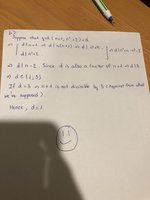I'm not sure if I've started in the right place.
So far I'm using the assumption that if d divides n+1 then n+1 = d(k). for some integer k
Similarly if d divides n^2+2 then n^2+2=d(m). for some integer m
I've also tried the assumption that, letting a=n+1 and b=n^2+2, then if d divides a and d divides b, then d divides ab. This also reaches a dead end and I'm not sure where to go from there.

So far I'm using the assumption that if d divides n+1 then n+1 = d(k). for some integer k
Similarly if d divides n^2+2 then n^2+2=d(m). for some integer m
I've also tried the assumption that, letting a=n+1 and b=n^2+2, then if d divides a and d divides b, then d divides ab. This also reaches a dead end and I'm not sure where to go from there.

Last edited by a moderator:

